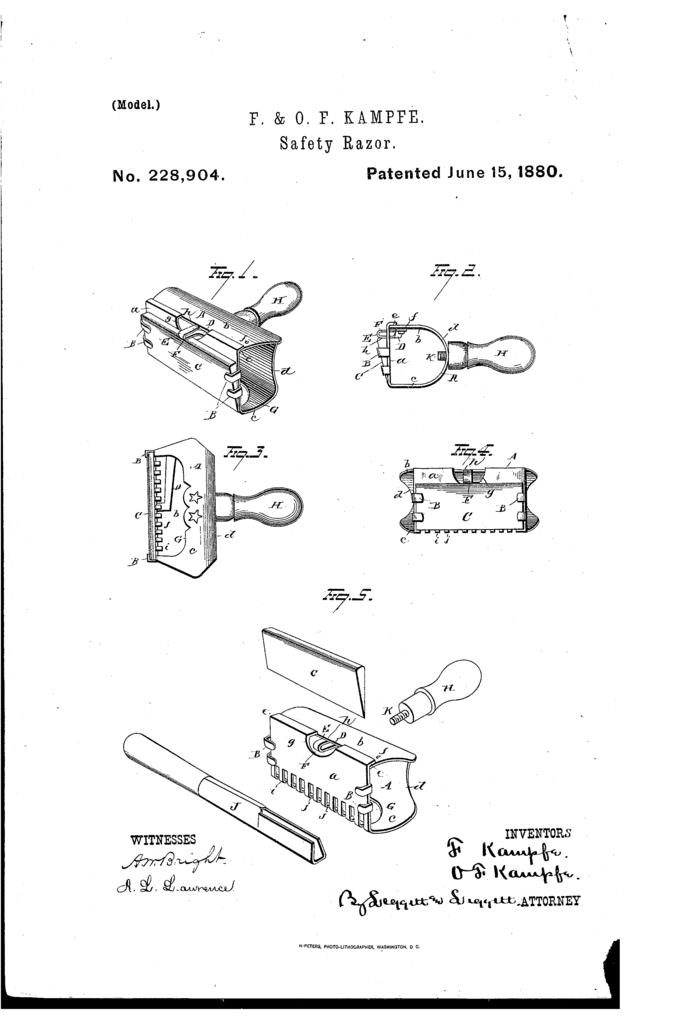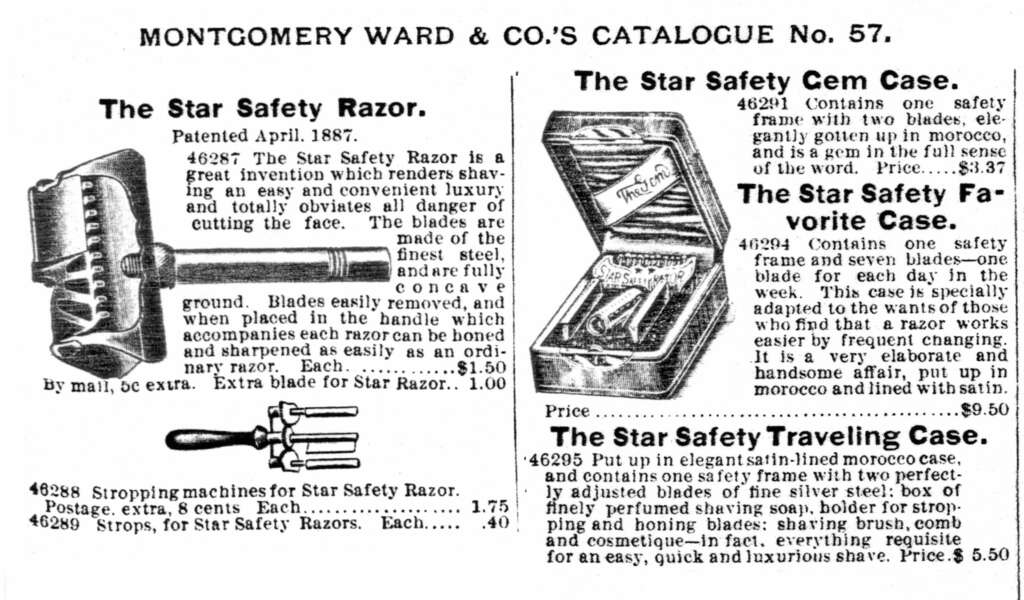One of the earliest recognisable safety razors – as the term is commonly understood today – was Frederick and Otto F. Kampfe’s 1880 patent. There is some indications that the first razors were made as early as 1875, but the Star trademark seems to have been in use since 1880. The patent1 for the Star razor is also one of the earliest – but not the first2 – use of the term “safety razor”.
Be it known that we, FREDERIC KAMPFE and OTTO F. KAMPFE, of New York, in the county of New York and State of New York, have invented certain new and useful Improvements in Safety-Razors; and we do hereby declare the following to be a full, clear, and exact description of the invention, such as will enable others skilled in the art to which it appertains to make and use the same…
US patent 228,904
The Star razor used wedge blades, which were replaceable but not disposable per see. The shaver was expected to have the skill and knowledge to sharpen and hone the blade as needed. In addition to the removable blade, the patent claimed the comb guard as a novel invention, as well as the ability to store the handle in the blade holder. The blade holder was – as can be seen from the patent drawing – was much larger than the head of a Gillette style razor.

The size of the head is also – I do believe – why the early Kampfe razors sometimes are called lather catchers. As it is described in the patent text itself:
The sharp edge of the razor rests against the grated or toothed edge of the front plate, and as the hair and soap are removed in the operation of shaving such refuse matter will be forced through the opening G in the bottom plate, and be retained within the hollow holder, thereby permitting of the use of the device without danger of soiling the fingers of the user.
US patent 228,904
In other words; it was designed from the start to retain the lather in the head, thus keeping the shavers hand free of soap and whiskers. The fact that this also allowed for the handle to be stored in the head seems to mostly have been a happy coincidence – good design often allows any one piece of a device to do multiple functions.
Kampfe’s Star razor was remarkable successful for being such an early design, and variations was for sale until after Gillette and others had popularised the idea of replaceable and disposable blades. During the production run several alterations and refinements were made to the razor, and Kampfe got at least twenty three more razor related patents. The handle was made slimmer and longer, and gained the familiar stars. The blade retention mechanism was refined and improved. The head shrunk some in size, and gained the word STAR on the guard plate.
Advertisement was aggressive, even more so after Gillette hit the market. Some of the advertisements were direct attacks on Gillette’s claim that the disposable blade made stropping and honing a thing of the past. Others advocated the superiority of the convex blade over the flat. In 1911 an advertisement claimed the Star razor had five million users, and other ads claimed that the many imitators proved it’s success.

Despite the claims of success, it was clear that the day of the wedge blade was over. In 1913 Kampfe introduced the Star Cru Steel3 rib backed blade – a a single edge thin rigid blade having a folded reinforcing rib clamped to the blade opposite the cutting edge. The broadly similar Stoll blade they introduced around 1915 was advertised as being suitable for “Stoll, Superior, Ever Ready, Gem, Gem Junior, Star and other safety razors”.4
It’s also worth nothing, I believe, that one of the founders of Gem Cutlery Co – who would go on to make the GEM razors – was a former employee of Kampfe. In addition the Kampfe Brothers became a subsidiary of American Safety Razor Corp., which was formed when GEM and EverReady merged. So the history of the GEM and the Kampfe is intertwined and most likely complex.
As far as my sources tells me, the Star razor was last offered for sale in the 19204 Sears Roebuck catalogue. The wedge shaped blades were last listed in the same catalogue six years later before that too disappeared. Not a bad run for a razor that was first introduced in 1875 as the very first safety razor.
For those wanting to learn more about the history of Kampfe Brothers, I would recommend Robert K Waits’ “Safety Razor Compendium”.
Footnotes
- The patent can be read either at Google Patents or at Razors.click
- For a deep dive into that rabbit hole, see the article Razors.click wrote on the subject
- Cru Steel is most likely an abbreviation for crucible steel, a form of steel that were considered superior to others when it came to making machine tools and cutting edges.
- EverReady offered a single edge rib backed blade suitable for “Yankee, Star and Gem frames” as early as 1906 – 50 cents for seven, while the Star wedge replacement blade cost 1 dollar each.
- 1920 was also the year when Gillette sold two million razors and a whooping 19 million blades.

Pingback: John Monks' shaving apparatus - Wegian WetshavingWegian Wetshaving
Pingback: Jeremiah Reichard's 1906 Lather Catcher - Wegian WetshavingWegian Wetshaving
Pingback: Louis Heckel's safety-razor-blade holder - Wegian WetshavingWegian Wetshaving
Pingback: Diamond Edge razor - patent and brief history - Wegian WetshavingWegian Wetshaving
Pingback: Paul Zammet and the Improved Razor Guard - Wegian WetshavingWegian Wetshaving
Pingback: The safety razor of James Hartness - Wegian WetshavingWegian Wetshaving
Pingback: Adjustable wedge razor - Wegian WetshavingWegian Wetshaving
Pingback: Scimitar razor for wedge and non-wedge blades - Wegian WetshavingWegian Wetshaving
Pingback: A simple wedge razor - Wegian WetshavingWegian Wetshaving
Pingback: Harry Clough and his improved holder for detachable blades - Wegian WetshavingWegian Wetshaving
Pingback: A neat folded sheet metal razor - Wegian WetshavingWegian Wetshaving
Pingback: The safety razor of Gustavus Rein - Wegian WetshavingWegian Wetshaving